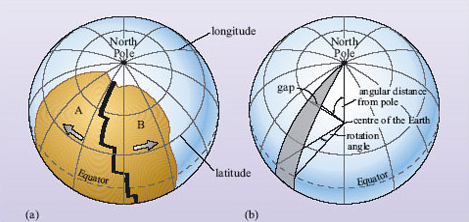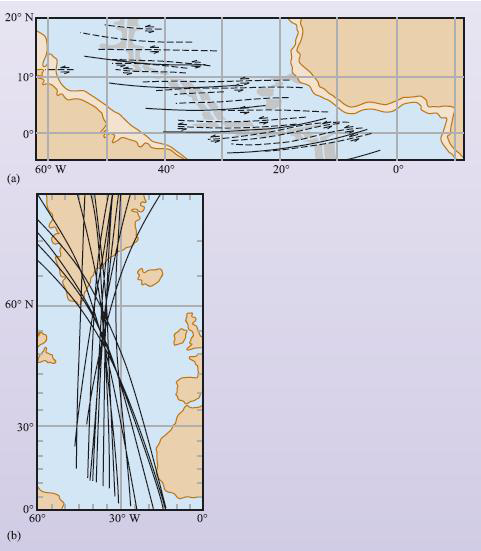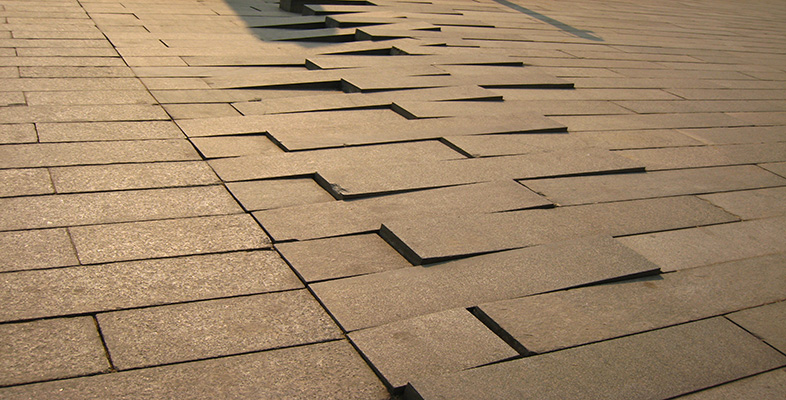4.3 Plate motion on a spherical Earth
Earth's tectonic plates are continuously in motion with respect to each other, and together they form the closed surface of a sphere (i.e. the Earth's surface). Understanding the movement of plates, therefore, requires a geometrical analysis of motions over a spherical surface. This is described in the Euler (pronounced 'oiler') geometrical theorem, which shows that every displacement of a plate from one position to another on the Earth's surface can be regarded as a simple rotation of that plate about a suitably chosen axis, known as an Euler pole or pole of rotation, which passes through the centre of the Earth.
Plate movement on a spherical Earth is illustrated in Figure 26. Two plates, A and B, are separating at a constructive plate boundary and rotating about a pole of rotation (which in this case is the North Pole). The constructive plate boundaries lie along lines of longitude, whereas the transform faults are parallel to lines of latitude. Lines of longitude are great circles with centres that coincide with the centre of the Earth; lines of latitude, which are at right angles to lines of longitude, are small circles with centres displaced from the Earth's centre. When the plates separate, the gap between them increases but, quite obviously, they separate a smaller amount close to the North Pole than at the Equator.

Question 21
What effect does this have on local full and half spreading rates along the length of the constructive plate boundary?
Answer
Spreading rates measured close to the pole of rotation will be small while those further away will be much greater.
This aspect of spherical geometry explains why relative plate motions expressed simply in terms of mm y−1 vary along the length of a plate margin. Needless to say, poles of rotation are not all located at the geographical poles but can fall anywhere on the Earth's surface. For example, the Mid-Atlantic Ridge has variable spreading rates along its length, with values of 37-40 mm y−1 in the South Atlantic, to lower values of 23-26 mm y−1 in the North Atlantic (Figure 8).
Question 22
What do these variations in spreading rate tell you about the location of the pole of rotation of the South American Plate?
Answer
Spreading rates are lower in the North Atlantic and so the pole of rotation must be located somewhere in the northernmost Atlantic Ocean.
The location of the pole of rotation can be determined more accurately from the orientation of the transform faults that cut the Mid-Atlantic Ridge. Transform faults lie along small circles and, by definition, lines at right angles to them will pass through the pole of rotation (Figure 27a). Using this method, the pole of rotation of the South Atlantic Plate can be shown to be located in the North Atlantic, south of Greenland (Figure 27b).

Finally, some plates have an internal pole of rotation that results in some complex consequences for relative plate motions. The first, and possibly most obvious, is that the real motion of the plate becomes one of rotation. The African Plate (Figure 25) is a good example. The southern part of the African Plate is moving to the east while the northern part is moving to the west - the plate is rotating anticlockwise about a pole located somewhere near the Canary Islands, off the northwest coast of Africa. The second consequence is that an internal pole can lead to a given plate boundary transforming from a constructive plate boundary through a conservative plate boundary to a destructive plate boundary along its length, although this is not apparent around the African Plate.
